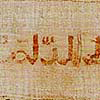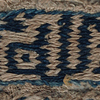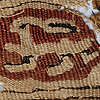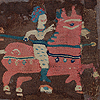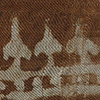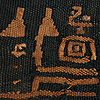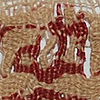 |
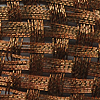
3065
Antique Early Islamic Metallic Trim, Metal Foil Wrapped Around Silk
Egypt,
Fatimid Textile Period
969 - 1171 A.D.
Size 7" x 1.5"
Size 18 x 4cm
Below are Detail Images
Provenance: Formerly in the H. Kevorkian Collection
Cf: Tissus D’Egypte, Bouvier Collection Geneva
Analysis prepared by Dr.Julia Galliker, PhD, 10/30/2015
|
 An Important Early Islamic Broder Trim
An Important Early Islamic Broder Trim

Analysis prepared by Dr.Julia Galliker, PhD, 10/30/2015
Fragment: Woven band consisting of lamellae (metal foil or gilded base) wrapped
paired yarns in both the warp and weft
Fragment
Dimensions (based on measurement of intact woven areas only)
Total height: 17.6 cm
Total width: 3.6 cm
Selvedge width on each side: 0.33 cm
Photo: 1 gold fragment dimensions
Yarn
characteristics
- Golden brown colored silk core comprising S twist 2 ply untwisted
or lightly twisted singles.
- Lamella (Metal foil or gilded base material) cut into strips
- Avg lamella width: 440 um
- Avg yarn diameter including core and lamella strips is: 245 um
- This fragment includes yarns wrapped in both and S and Z direction
as discussed below.
Photo: 2 weft yarn at 150 x mag
Photo: 3 warp yarn at 150 x mag
Warp
characteristics
Avg warps/cm
- Selvedges: 48/cm
- Central section: 26-28/cm
Warp composition: 110 total warps comprising 2 borders with 16 warps on
each side and 78 warps in the center region.
Structure: paired warps in extended tabby. Lamella direction was a specific
design choice in preparing the loom.
Warps in the selvedges are comprised of warp pairs with lamella in a SZ (\/)
for one selvedge with the other in a ZS (/\) combination. The warps in the
center section follow a the following pair sequence: SS ZZ SS ZZ.
The intended effect of these different combinations was to emphasize the
metallic material by making the foil direction less observable. The effect is
a nuanced and sophisticated piece with subtle textural and light differences.
Photo: 4 width of textile at 5 x mag
Photo: 5 Warp foil twist direction analysis 50 x mag
Photo: 6 Alternating warp s z 15 x mag
Weft
characteristics
Avg wefts/cm: 16-18/cm grouped into pairs
Note that weft density varies significantly depending upon the weave
design.
Structure: paired wefts in extended tabby. Lamella direction was a specific
design choice with paired weft insertion comprising one S and one Z warp
resulting in a pair. Maintaining this sequence in successive wefts would have required
two shuttles fixed together or a single shuttle with two spools. Since the
lamella direction does not reverse, the shuttle(s) would have to be held in
the same parallel orientation throughout the weaving process with the left
side of the shuttle entering first on throws to the left, and the right side
entering first on throws to the right.
Photo: 7 warp and weft foil twist direction 50 x mag
Weave structure Extended tabby with paired warps and wefts with patterning achieved by
various warp and weft float combinations. No float patterning mistakes are
discernable.
Loom type Band loom - refers to any special loom for weaving narrow bands.
Possible uses Such bands were often applied to the edge of a garment for decorative
purposes. However, no distension is evident on either selvedge. No sewing
thread fragments are visible on the piece.
Impression The piece is a fine example of band loom weaving. Apart from slight color
variation in the lamellae, there are no signs of wear. There is no visible
damage to the silk core such as yarn breaks or distension. The lamellae are
similarly intact and undamaged. No foreign matter such as soil or other
contaminants are visible. There is no definitive evidence to suggest that the
piece came from an archaeological context. Note that this observation is
suggestive, but not definitive.
Analysis
 .
. |
 |
